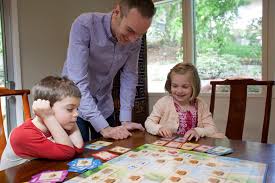by Yvonna Graham, M.Ed; www.dyslexiakit.net
GET RID OF BAD BOOK VIBES:
Students who have trouble learning to read often develop negative reactions to books. By the time I see them as a reading tutor, some of these students actually shudder and get tears in their eyes when I bring out a book! This unfortunate pairing can get in the way of making progress with reading. I’ve found using board games can remove the negative reaction, introduce an element of fun and play, and allow me to provide instruction in a way the student enjoys. Since students remember happy things and forget things that cause pain (retaining the negative emotion but not the content) it only makes sense to stop torturing the child and let her have fun while learning!
MY FAVORITE READING COMPREHENSION BOARD GAMES:
Parents often ask me what board games to use, so I felt a recommendation was in order. I’ve had excellent success using Learning Well games by EduPress, which come in three grade levels (2.0-3.5, 3.5-5.0, and 5.0-6.5) The playing cards in the games have short passages to read followed by a question to answer in order to move ahead on the board. Unlike many “educational” games, these are interesting and fun for the child. Most children love rolling the dice or spinning the arrow to make their way around the board, and the reading comes in bite-sized pieces that are not as intimidating as a book.
HOW TO PLAY A GAME WITH A CHILD:
It’s important when playing with the child to provide plenty of support so the reading doesn’t bog him down or make her want to quit playing. Here’s what works best. Select the game for the intellectual level of the child, not for the child’s reading level. That way, the questions will be interesting and challenging. Then, when the child needs to read a card, the adult reads it aloud while the child tracks along, looking at the words as he hears them. Ask the child to re-read the card silently to be sure he understands before tackling the question. Answer any questions the child has about the card. After all, this isn’t a test! This is a game! You want the child to succeed on most questions, and furthermore to win the game most of the time, thus pairing happy feelings with reading.
AVOID TESTING AND JUDGING:
As an adult working with a child, it’s far too easy to fall into a “testing mode” in which the adult is not providing support, practice, and instruction, but rather forcing the child to “perform before a judge” by reading aloud material they’ve not seen before, almost insuring mistakes, failure, and bad feelings. Even worse, some adults feel a need to prove they are smarter than the child by always winning or gloating over mistakes. So I urge the parents of my students to play games in “helper” mode —providing so much support that the student finally says, “I’ve got it; I can do this one myself!” Parents naturally want to know how the child will learn if parents do all the work. But children are avid learners, and when not made to feel inadequate will absorb massive amounts of new information by simply watching and listening to parents. If parents express delight in the child’s attempts, the child will respond with even greater effort and attention. Modeling is the most powerful teaching device in the universe. Games provide the perfect way to model reading for the reluctant reader.
